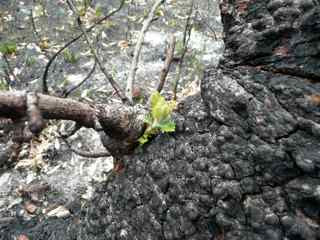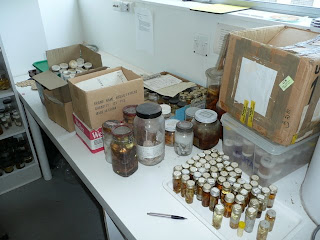As JFK might have said "Ich bin ein Berlogger"!
So you might like to hear about yesterday's adventures, as we continue our holiday at Boat Harbour on the warm and sunny North West coast of Tasmania.
Right next door is Rocky Cape National Park, one of Tassie's least known parks, but a little gem in many ways. It's mostly covered in florally rich coastal heathland, and is the only locality in Tas for Serrated Banksia, a wonderfully gnarled small tree with bad banksia men cones. But the trouble with coastal heath is that is catches fire at the drop of a........ match. And that's what happened back in November to the eastern end of the park. It'll be OK again in a couple of years, but right now it looks more than a bit devastated.
 East end of Rocky Cape NP after the November fires.
East end of Rocky Cape NP after the November fires.
Those are wallaby tracks.But it's wonderful to see the shoots and seedlings springing up.
 Fresh shoot on a scorched serrated banksia.
Fresh shoot on a scorched serrated banksia. Fresh shoots on a scorched gum tree.
Fresh shoots on a scorched gum tree.The plants are all fire-resistant, with their buds well-protected below ground or in the centre of the plant. The grass trees neatly record the amount of growth since their leaves were scorched.
 Grass tree shooting after fire.
Grass tree shooting after fire.
All the green growth has appeared since the November fire.
Jean and I have recently read
Beyond Awakening, a book by Ian McFarlane on the sad story of the aboriginal tribes of north west Tas after European "contact". It's hardly conceivable that the native tribes were gone from this region just 40 years after Europeans settled here, but as a consequence we know so little about how they lived. I always try to picture the original inhabitants in this landscape, and their presence is felt particularly strongly at the caves in the park.
Wet Cave is just above Sisters Beach, a steep climb from the shore and facing south, so perhaps not the best real estate. It's quite a deep cave and usually full of water, but perhaps because of the fire the water level was really low yesterday, two metres or more below normal. We could go some way in but even then my head torch wasn't strong enough to illuminate the back of the cave. I'll have to come back with something stronger (and a little boat, and a ring, precious.....).
 Wet Cave from the inside.
Wet Cave from the inside.
The other site at the eastern end of the park is Lee Archer Cave, which is drier, more open, closer to the sea and faces northeast. Much more of a des res, as shown by the larger midden deposit of shells at the entrance. Mr Lee Archer was a local magistrate in the early 1800s, and he was probably responsible for a couple of test digs into the greenish, coppery-looking vein of rock below the cave that are marked as a "mine" on some maps.
 The entrance of Lee Archer Cave.
The entrance of Lee Archer Cave.
There are a couple of other caves in the park, including one secret one that I haven't found yet. Watch this space!



























